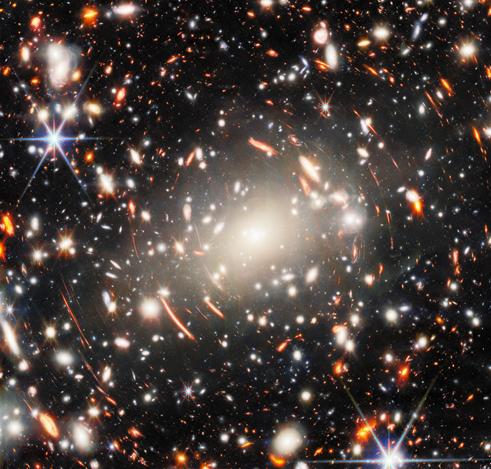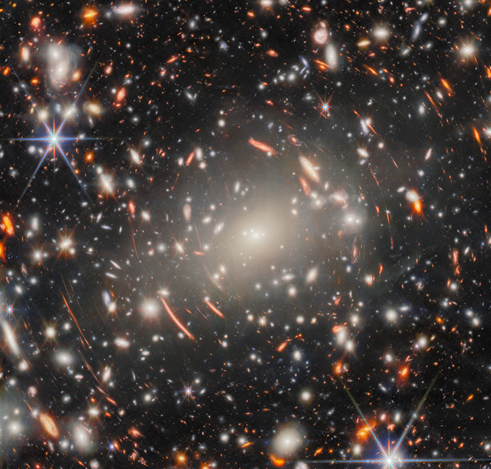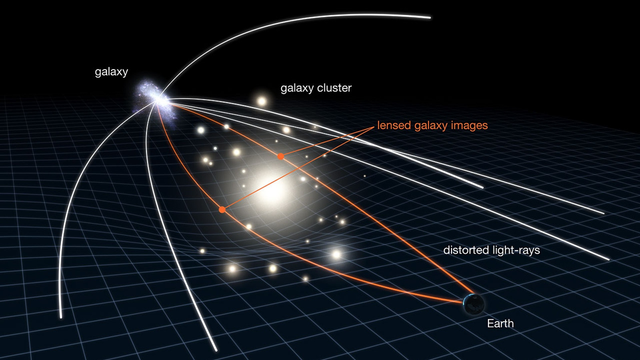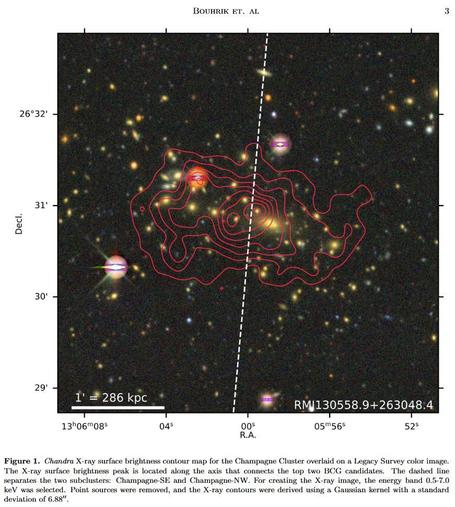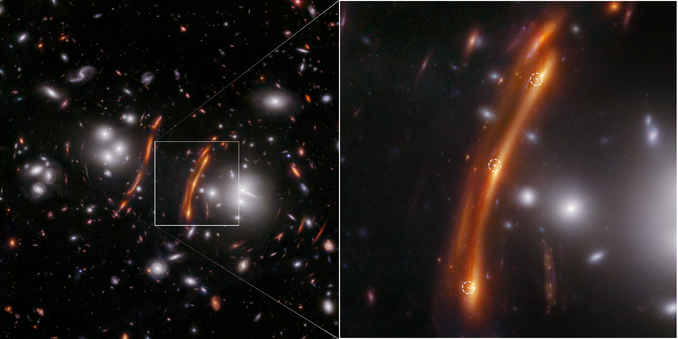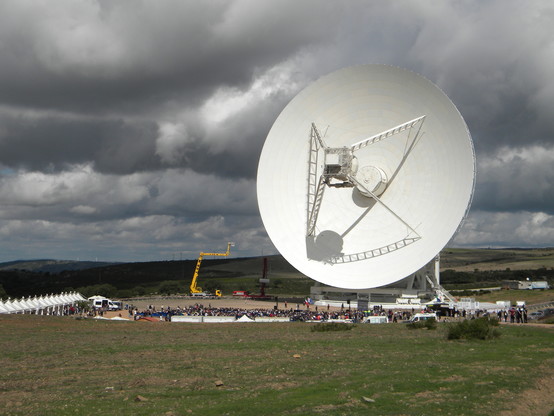Incredible new #JWST deep field (120 hours!) released by folks from ESA/NASA Webb teams.
Not only is nearly everything in this image a galaxy (the two spiky stars are not), but those curved arcs are images of galaxies beyond this cluster, which are projected and warped into our view thanks to the power of gravity!
It's called a gravitational lens. To visualise what's happening, take a look at this diagram.
There are distant galaxies that we can't normally see. There's also a galaxies between them and us, with lots of mass.
This mass warps space-time and bends the distant galaxy light towards us so we see them.
I am amazed. You should be amazed. This is a really epic image.
Galaxy image and alt-text credit: ESA/Webb, NASA & CSA, H. Atek, M. Zamani (ESA/Webb)
Diagram credit: NASA, ESA & L. Calçada
One last question, if someone knows: Turner & Gott 1976 were on the right track with density-based clustering, why was this changed to single-linkage ("friends-of-friends") over the course of time? From what I understand now, it was a change for the worse...
Directly Imaging the Cooling Flow in the Phoenix Cluster
In the centers of many galaxy clusters, the hot ($\sim$10$^7$ K) intracluster medium (ICM) can become dense enough that it should cool on short timescales. However, the low measured star formation rates in massive central galaxies and absence of soft X-ray lines from cooling gas suggest that most of this gas never cools - this is known as the "cooling flow problem." The latest observations suggest that black hole jets are maintaining the vast majority of gas at high temperatures. A cooling flow has yet to be fully mapped through all gas phases in any galaxy cluster. Here, we present new observations of the Phoenix cluster using the James Webb Space Telescope to map the [Ne VI] $λ$7.652$μ$m emission line, allowing us to probe gas at 10$^{5.5}$ K on large scales. These data show extended [Ne VI] emission cospatial with (i) the cooling peak in the ICM, (ii) the coolest gas phases, and (iii) sites of active star formation. Taken together, these imply a recent episode of rapid cooling, causing a short-lived spike in the cooling rate which we estimate to be 5,000-23,000 M$_\odot$ yr$^{-1}$. These data provide the first large-scale map of gas at temperatures between 10$^5$-10$^6$ K in a cluster core, and highlight the critical role that black hole feedback plays in not only regulating but also promoting cooling.
in the #arXiv
Discovery of the Champagne Cluster 🥂
by Faik Bouhrik, Rodrigo Stancioli, and David Wittman
https://arxiv.org/abs/2501.09901
#Cosmology #Astrophysics #Champagne #cluster #ChampagneCluster #galaxies #GalaxyCluster #Astrodon #science #STEM #news #Chandra #xray #telescope
Discovery and Multi-Wavelength Analysis of a New Dissociative Galaxy Merger: The Champagne Cluster
We report the discovery of a new binary galaxy cluster merger, the Champagne Cluster (RM J130558.9+263048.4), using a detection method that identifies dynamically active clusters in the redMaPPer SDSS DR8 photometric galaxy cluster catalog. The Champagne Cluster exhibits the classic X-ray morphology of a post-pericenter dissociative galaxy cluster merger: an X-ray peak located between two galaxy overdensities at the same redshift. We conducted a Keck/DEIMOS survey and obtained redshifts for 103 member galaxies. The redshift analysis indicates a relative velocity of 411 $\pm$ 180 km/s between the two subclusters, which suggests that the merger is happening near the plane of the sky. We used cosmological simulations to find analogous systems to constrain the time since pericenter (74-250 Myr) and the angle the merger axis makes with the plane of the sky (62$^\circ$-90$^\circ$) at the 68$\%$ confidence level. We estimated the bulk temperature (8.20 $\pm 1.2$ keV) and total X-ray luminosity (5.2 $\pm$ 0.8 $\times$ $10^{44}$ erg $\times$ $s^{-1}$) of the intracluster medium using $\textit{Chandra}$ archival data.
Galaxy cluster PLCK G165.7+67.0 and SN H0pe Inset (NIRCam)
🌕🌌🔭
This is more than just a pretty picture—it's a window into both the distant past and the ever-evolving puzzle of how the universe expands. Supernova H0pe
#jwst #Supernovae #H0pe #galaxycluster
in the #arXiv
The Tale of Two Telescopes: How Hubble Uniquely Complements the James Webb Space Telescope: Galaxies
by Rogier A. Windhorst and co-authors
https://arxiv.org/abs/2410.01187
#Hubble #HST #JWST #space #telescope #spacetelescope #Webb #galaxies #galaxycluster #astronomy #astrophysics #astrodon #universe #cosmology #science #STEM #technology #HubbleSpaceTelescope

The Tale of Two Telescopes: How Hubble Uniquely Complements the James Webb Space Telescope: Galaxies
In this paper, we present a simple but compelling argument, focusing on galaxy science, for preserving the main imagers and operational modes of the Hubble Space Telescope (HST) for as long as is technically feasible. While star-formation started at redshifts z$\gtrsim$10$-$13, when the universe was less than 300$-$500 Myr old, the CSFH did not peak until z$\simeq$1.9, and has steadily declined since that time. Hence, at least half of all stars in the universe formed in the era where HST provides its unique rest-frame UV view of unobscured young, massive stars tracing cosmic star-formation. By rendering a subset of the 556.3 hours of available HST images in 12 filters of the Hubble Ultra Deep Field (HUDF) in an appropriate mix of colors, we illustrate the unique capabilities of HST for galaxy science emphasizing that rest-frame UV$-$optical wavelength range. We then contrast this with the 52.7 publicly available hours of JWST/NIRCam images in 8 filters of the same HUDF area from the JADES project, rendering these at the redder near-IR wavelengths to illustrate the unique capabilities of JWST to detect older stellar populations at higher redshifts, as well as very dusty stellar populations and Active Galactic Nuclei (AGN). HST uniquely probes (unobscured) young, hot, massive stars in galaxies, while JWST reveals more advanced stages of older stellar populations, as well as relatively short-lived phases where galaxies produce and shed a lot of dust from intense star-formation, and the very high redshift universe (z$\gtrsim$10$-$11) not accessible by HST. We conclude that HST and JWST are highly complementary facilities that took decades to build to ensure decades of operation. To maximize return on investment on both HST and JWST, ways will need to be found to operate HST imaging instruments in all relevant modes for as long as possible into the JWST mission.
#JWST observations shed more light on the nature of a distant #galaxycluster
JWST observations shed more light on the nature of a distant galaxy cluster
Astronomers from the Nanjing University in China and elsewhere have performed high-resolution observations of a distant galaxy cluster known as CL J1001+0220 using the James Webb Space Telescope (JWST). The observational campaign, described in a paper published March 8 on the preprint server arXiv, yields important information regarding the nature of this cluster.
The Sardinia Radio Telescope, a 64-metre fully steerable radiotelescope located near San Basilio, Province of Cagliari, Sardinia, Italy, on the day of its inauguration in 2013.
A paper in #arXiv today reports on its observations of the Coma Cluster of galaxies: https://arxiv.org/abs/2402.07306
#astronomy #astrophysics #astrodon #telescope #Sardinia #radiotelescope #SRT #SardiniaRadiotelescope #Coma #cluster #galaxies #galaxycluster #galaxyclusters #observations #space #science #research #STEM #Italy
Sardinia Radio Telescope observations of the Coma Cluster
We present deep total intensity and polarization observations of the Coma cluster at 1.4 and 6.6 GHz performed with the Sardinia Radio Telescope. By combining the single-dish 1.4 GHz data with archival Very Large Array observations we obtain new images of the central radio halo and of the peripheral radio relic where we properly recover the brightness from the large scale structures. At 6.6 GHz we detect both the relic and the central part of the halo in total intensity and polarization. These are the highest frequency images available to date for these radio sources in this galaxy cluster. In the halo, we find a localized spot of polarized signal, with fractional polarization of about 45%. The polarized emission possibly extends along the north-east side of the diffuse emission. The relic is highly polarized, up to 55%, as usually found for these sources. We confirm the halo spectrum is curved, in agreement with previous single-dish results. The spectral index is alpha=1.48 +/- 0.07 at a reference frequency of 1 GHz and varies from alpha ~1.1, at 0.1 GHz, up to alpha ~ 1.8, at 10 GHz. We compare the Coma radio halo surface brightness profile at 1.4 GHz (central brightness and e-folding radius) with the same properties of the other halos, and we find that it has one of the lowest emissivities observed so far. Reanalyzing the relic's spectrum in the light of the new data, we obtain a refined radio Mach number of M=2.9 +/- 0.1.
Hey #GalaxyCluster people out there! I have a cone of #galaxies coords+spec-zs to find member gals for a cluster around a given centre.
Is there any good paper NOT using spherical infall/caustic-vel-modelling to find members? Method as agnostic as possible desired, as I do not want to put anything in the selection that I want to get out of the evaluation in the end...
